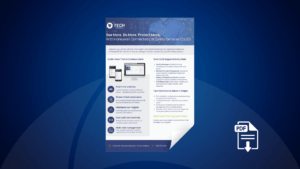By Chris Skinner, Director of Security & Healthcare Technologies

When we talk about integrated physical security, the conversation often drifts straight to the flashiest tech: AI-enhanced cameras, real-time analytics, automated alerts. But no matter how advanced the system, one basic question sits at the core of it all: who is allowed in?
That’s why access control isn’t just another layer in your security stack—it’s the foundation. From doors and elevators to data centers and storage closets, access control defines the rules of engagement. It decides who gets in, where they can go, and what happens when something doesn’t line up.
And when it’s well integrated with the rest of your systems, it does a lot more than open doors.
Access Control as the Source of Truth
Modern access control platforms do much more than accept or deny a badge swipe. They manage digital credentials, monitor activity in real time, and enforce policies consistently across locations. They can support mobile access, multi-factor authentication, and integration with video, intrusion, visitor management, and even operational systems like Active Directory.
But most importantly, access control provides context. It answers questions like:
- Was that door opened with a valid credential?
- Who was on site at 3:07 a.m. when the alarm went off?
- Has this badge been used in multiple locations too quickly to be physically possible?
It’s this kind of detail that turns access control into a critical decision-making tool—not just a point solution. And when an incident occurs, access data becomes one of the first places investigators turn. A well-managed system gives you clear audit trails, clean logs, and a chronological map of movement. It can help verify claims, detect policy violations, or even identify insider threats.
A Smarter Way to Manage Credentials
Credential lifecycle management is one of the most overlooked aspects of access control—and one of the most powerful. When a new hire starts, their access can be provisioned immediately and precisely: only the doors, floors, and timeframes that align with their role. As they change departments or shift responsibilities, their permissions can update automatically. And when they leave the organization? Their credentials can be instantly deactivated across every site and system.
This gets even stronger when access control systems are tied to an organization’s Active Directory. That integration eliminates duplicate work and improves accuracy—HR updates an employee’s status once, and their physical access updates in real time.
And beyond security, access control can help enforce safety standards. In warehouse and industrial environments, credentials can be tied to employee certifications like OSHA or forklift operation. If a certification expires, the system can automatically restrict access to specific areas or equipment. It’s a smart way to protect both your employees and your organization.
Integration in Action: More Than Just Door Control
To really see the value of access control integration, let’s shift to a real-world example. Imagine a hospital scenario where a behavioral health patient unexpectedly elopes from a secure unit. With a well-integrated access and video system, security can instantly pull up camera footage from adjacent doors, check which credentials were used in that timeframe, and determine whether the exit was forced, assisted, or credentialed.
That’s actionable intelligence. You’re not just seeing what happened—you’re understanding how and when it occurred, and who might be involved. And you’re able to respond in real time, whether that’s locking down nearby exits or alerting staff via mobile communications systems.
In high-pressure environments, these moments matter. Integration brings speed, clarity, and accountability.
Compliance, Liability, and Peace of Mind
For many organizations—especially in healthcare, education, and government—access control is also a compliance requirement. Whether you’re protecting patient data, securing controlled substances, or meeting federal credentialing standards, integrated access systems help demonstrate that protocols are being followed and access is properly restricted.
That’s where experience matters. I’ve worked on systems that needed to meet rigorous federal guidelines, including FICAM and HSPD-12 standards. Those environments don’t leave much room for error. A well-designed access control strategy is essential not only for physical protection but also for audit readiness and liability defense.
Even in less regulated industries, access control brings peace of mind. It’s the one system that tells you—without guessing—whether someone belongs where they are.
Smart Doesn’t Have to Mean Complicated
There’s a common misconception that integrated systems are too complex or overwhelming to manage. But in reality, integration should simplify operations, not add friction.
A unified access platform allows administrators to manage users from a single dashboard, apply consistent policies across sites, and get clear reports when something goes wrong. And for end users, modern access control is smoother than ever—mobile credentials, touchless readers, and smart permissions make security feel less like a barrier and more like a built-in part of the environment.
The key is thoughtful design. Every facility has different priorities. A school might focus on perimeter lockdowns and visitor check-ins. A hospital may prioritize zone-based restrictions and emergency override controls. The best systems are built around the way people actually use the space.
Access Control Is the Starting Line
At Tech Electronics, we treat access control as the starting point for any truly integrated security strategy. Because without clear rules about who’s allowed in—or out—every other tool is working with incomplete information.
We’ve helped organizations across industries deploy access solutions that balance high-level protection with everyday usability. From large-scale government facilities to private-sector campuses to community hospitals, our team designs systems that scale, adapt, and protect.
Security systems should help your team move with confidence—not get in the way. That’s what access control, done right, makes possible.
Let’s talk about how access control can strengthen your security ecosystem—while making your day-to-day operations easier.
Tech Electronics can help you design an integrated solution that works for your people, your space, and your mission.
Want to learn more about integrated security for your facility? Contact us.



